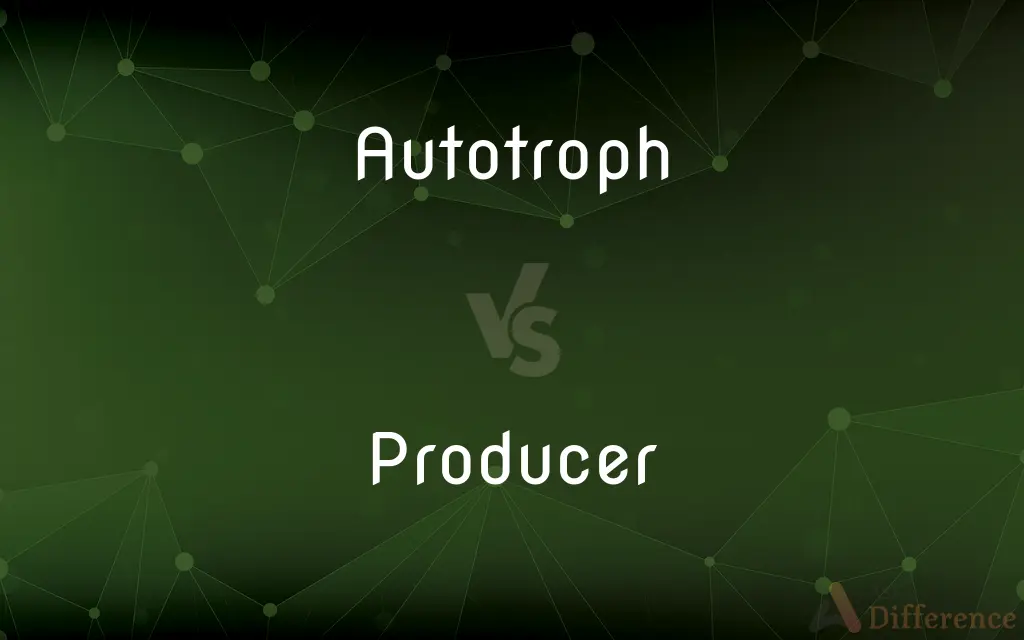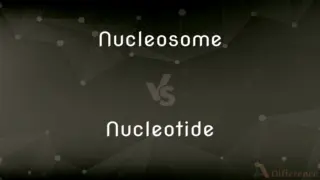Autotroph vs. Producer — What's the Difference?
By Urooj Arif & Fiza Rafique — Updated on March 29, 2024
Autotrophs are organisms that produce their own food from inorganic substances, while producers are any organisms that produce biomass from inorganic compounds, encompassing all autotrophs.

Difference Between Autotroph and Producer
Table of Contents
ADVERTISEMENT
Key Differences
Autotrophs synthesize their own food using light or chemical energy, without needing organic compounds from their environment. On the other hand, producers refer to organisms that contribute to the base of an ecosystem's food web by generating organic material from inorganic sources, which includes all autotrophs as a subset.
Photosynthetic autotrophs, like plants and algae, use sunlight to convert carbon dioxide and water into glucose and oxygen. Whereas, producers can also include chemosynthetic organisms that produce food through chemical reactions, underscoring the broader category producers represent.
Autotrophs are characterized by their method of obtaining energy, either through photosynthesis or chemosynthesis. Producers, however, are defined by their role in the ecosystem, serving as the foundation for the food chain by creating organic matter that other organisms consume.
The concept of autotrophs focuses on the biological and physiological processes enabling self-nourishment. In contrast, the term producers emphasizes ecological roles, highlighting the importance of these organisms in supporting food webs and recycling inorganic compounds into forms usable by consumers.
While all autotrophs are producers, not all producers are strictly autotrophs if considering broader ecological functions, such as detritivores in some contexts. This distinction is crucial in understanding ecosystem dynamics, where the role of producing biomass may extend beyond traditional autotrophic processes.
ADVERTISEMENT
Comparison Chart
Definition
Organisms that produce their own food from inorganic sources.
Organisms that produce biomass from inorganic substances.
Types
Photosynthetic and chemosynthetic.
Includes all autotrophs and sometimes broader ecological roles.
Energy Source
Light or chemical reactions.
Primarily light for photosynthesis, chemical energy for others.
Role in Ecosystem
Self-sustaining food producers.
Base of the food web, supporting other life forms.
Ecological Importance
Essential for energy conversion from abiotic to biotic.
Fundamental for biomass production and energy flow in ecosystems.
Compare with Definitions
Autotroph
Organisms that produce their own food using sunlight or chemical energy.
Plants use photosynthesis to convert sunlight into glucose.
Producer
Organisms that convert inorganic compounds into organic matter.
Algae in water bodies produce biomass through photosynthesis.
Autotroph
Can live in environments without organic nutrients.
Some bacteria in hydrothermal vents rely on chemosynthesis.
Producer
Serve as the foundational level of food chains.
Phytoplankton are primary producers feeding marine food webs.
Autotroph
Form the primary producers in most ecosystems.
Grass in a savanna ecosystem provides energy for herbivores.
Producer
Include plants, algae, and some bacteria.
Forests are vast areas of producers, creating habitats and food sources.
Autotroph
Self-sufficient in energy production.
Cyanobacteria in the ocean produce oxygen and glucose through photosynthesis.
Producer
Vital for carbon fixation.
Producers convert CO2 into organic carbon, reducing greenhouse gases.
Autotroph
Contribute to the oxygen supply on Earth.
Phytoplankton in oceans are major producers of oxygen via photosynthesis.
Producer
Influence ecosystem productivity and stability.
The diversity of producers in an ecosystem supports a variety of consumers.
Autotroph
An autotroph or primary producer is an organism that produces complex organic compounds (such as carbohydrates, fats, and proteins) using carbon from simple substances such as carbon dioxide, generally using energy from light (photosynthesis) or inorganic chemical reactions (chemosynthesis). They convert an abiotic source of energy (e.g.
Producer
Something that produces;
Maine is a leading producer of potatoes
This microorganism is a producer of disease
Autotroph
An organism that is able to form nutritional organic substances from simple inorganic substances such as carbon dioxide.
Producer
One that produces, especially a person or organization that produces goods or services for sale.
Autotroph
An organism capable of synthesizing its own food from inorganic substances, using light or chemical energy. Green plants, algae, and certain bacteria are autotrophs.
Producer
A person who supervises and controls the administrative, financial, and commercial aspects of staging a show or performance or of creating and distributing a video or audio recording.
Autotroph
(ecology) Any organism that can synthesize its food from inorganic substances, using heat or light as a source of energy.
Producer
A furnace that manufactures producer gas.
Autotroph
An organism which is autotrophic, i. e., an organism (such as most plants and certain microorganisms) which are capable of synthesizing its own food from simple organic substances, requiring only minerals as nutrients for growth, and using carbonate or carbon dioxide as a source of carbon and simple inorganic nitrogen as a nitrogen source; the energy required is derived from photosynthesis or chemosynthesis. Opposed to heterotroph. See also auxotroph.
Producer
(Ecology) An organism, such as a green plant, that produces its own food through photosynthesis or chemosynthesis and constitutes the first trophic level in a food chain; an autotroph.
Autotroph
Plant capable of synthesizing its own food from simple organic substances
Producer
(economics) An individual or organization that creates goods and services.
Producer
One who produces an artistic production, such as an album, a theater production, a film, a TV program, a video game, and so on.
Producer
(biology) An organism that produces complex organic compounds from simple molecules and an external source of energy.
Producer
An arrest for speeding after which the driver is allowed seven days (or ten, in the Republic of Ireland) in which to produce his/her driving licence and related documents at a police station.
Producer
(archaic) A furnace for producing combustible gas for fuel.
Producer
One who produces, brings forth, or generates.
Producer
One who grows agricultural products, or manufactures crude materials into articles of use.
Producer
A furnace for producing combustible gas which is used for fuel.
Producer
Someone who manufactures something
Producer
Someone who finds financing for and supervises the making and presentation of a show (play or film or program or similar work)
Common Curiosities
Are all plants both autotrophs and producers?
Yes, all plants are both autotrophs, through photosynthesis, and producers, as they form the basis of terrestrial food chains.
How do chemosynthetic autotrophs produce food?
Chemosynthetic autotrophs produce food by converting inorganic chemical compounds, such as hydrogen sulfide, into organic matter in the absence of sunlight.
Why are producers important to the ecosystem?
Producers are crucial as they initiate the conversion of inorganic substances into organic matter that serves as food for other organisms, driving the energy flow in ecosystems.
What distinguishes an autotroph from a producer?
Autotrophs are defined by their ability to synthesize food from inorganic substances, while producers include any organisms that contribute biomass to an ecosystem from inorganic compounds, highlighting the role in the food web.
Can producers be found in aquatic environments?
Absolutely, aquatic environments are home to producers like algae and phytoplankton that play critical roles in aquatic food webs.
What is the significance of producer diversity in an ecosystem?
Diversity among producers enhances ecosystem resilience, productivity, and stability by supporting a wide range of consumers.
Can producers survive in extreme environments?
Yes, some producers, especially certain bacteria, can thrive in extreme environments, like hot springs or deep-sea vents, through chemosynthesis.
Can fungi be considered producers?
Fungi are not considered producers as they decompose organic material rather than converting inorganic to organic substances.
Is photosynthesis the only process used by autotrophs?
No, while photosynthesis is common, some autotrophs use chemosynthesis, especially in environments without sunlight.
What role do producers play in the carbon cycle?
Producers play a key role in the carbon cycle by fixing carbon dioxide from the atmosphere into organic compounds during photosynthesis.
How do producers affect atmospheric oxygen levels?
Producers, especially through photosynthesis, release oxygen as a byproduct, significantly contributing to Earth’s oxygen supply.
How do producers support aquatic ecosystems?
In aquatic ecosystems, producers like phytoplankton and algae produce oxygen and serve as food for a variety of marine organisms.
Do all ecosystems have the same types of producers?
Different ecosystems have varied types of producers, adapted to specific environmental conditions, from desert plants to deep-sea bacteria.
Why is the study of autotrophs and producers important?
Studying autotrophs and producers is crucial for understanding ecosystem dynamics, biodiversity, and the impacts of environmental changes.
How do human activities impact producers?
Human activities can impact producers through deforestation, pollution, and climate change, affecting ecosystem balance and biodiversity.
Share Your Discovery

Previous Comparison
Chance vs. Fate
Next Comparison
Nucleosome vs. NucleotideAuthor Spotlight
Written by
Urooj ArifUrooj is a skilled content writer at Ask Difference, known for her exceptional ability to simplify complex topics into engaging and informative content. With a passion for research and a flair for clear, concise writing, she consistently delivers articles that resonate with our diverse audience.
Co-written by
Fiza RafiqueFiza Rafique is a skilled content writer at AskDifference.com, where she meticulously refines and enhances written pieces. Drawing from her vast editorial expertise, Fiza ensures clarity, accuracy, and precision in every article. Passionate about language, she continually seeks to elevate the quality of content for readers worldwide.














































